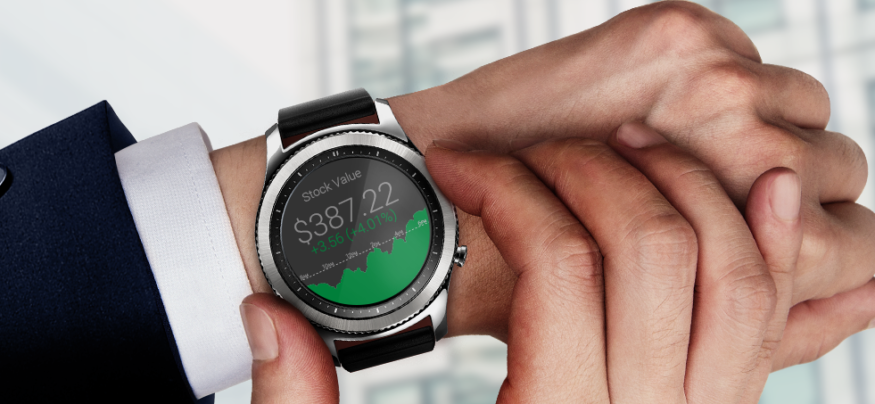Technology in banking is driving the plate-tectonic-like paradigm shifts from legacy sales-centric to solution-based, customer-centric operating models. The growing adoption of wearables in banking emphatically underscores the value placed on convenience and portability. Digital innovation and transformation has enabled a revolution of convenience to delight millennials and help traditional brick-and-mortar locations advance into the next generation of banking.
Wearables Shaping The Bank Branch of the Future
As surviving retail branches modernize, it’s imperative to integrate wearables and display technology into the bank of the future transformation process. Branch offices are in a unique position to capitalize on wearables in banking.
Wearables gained mainstream popularity through fitness and health application platforms like FitBit. The single-purpose portable fitness bands became gateway devices, introducing users to the wearables ecosystem gradually upgrading to multi-functional wearable devices like smartwatches.
International Data Corporation anticipates the worldwide wearables market to double by 2021, shipping over 240 million units annually. Watches are expected to account for 67 percent of the market with a 26.5 percent CAGR by 2021. IDC expects smartwatches to see a volume boost in 2019 as cellular connectivity and networks improve.
Smartwatches are easily embedded into everyday routines because they are wearable and “always-on.” They are the embodiment of convenience and portability. Just as smartwatches help monitor physical health, banks should innovate their smartwatch apps to help monitor financial health, and improve the in-bank experience.
[realted-promo]
To go beyond wearables, bluetooth beacons can utilize geolocation and frictionless identification methods like facial recognition and iris scans to instantly verify bank customers walking through the lobby.
Beacons also push personal greetings to the customer’s smartwatch while simultaneously notifying the specialist with customer account information. Human specialists handle the high-touch engagements, while self-help kiosks enable customers to handle frictionless transactions.
Offices are outfitted with video conferencing equipment enabling live engagements with remote specialists including mortgage, financial advisors and wealth managers. This reduces wait times and overflow. Utilizing large vibrant interactive Smart displays, both customer and specialist can interact and share content as if they were sitting side-by-side. Special areas can offer customers virtual reality headsets introducing consumers to bank products and services in an immersive and private manner. The customer’s trip concludes with a summary of activities performed along with a quick customer feedback survey.
The bank branches of the future transform a trip into an experience. Wearables in banking are the apex point where physical collaborates with digital in a seamless intuitive process that can immensely bolster customer experience, optimize efficiencies and revitalize foot traffic.
Rise of the Challenger Banks and the Solution-Centric Operating Model
Technology in banking brought about the natural migration away from branches to mobile/online banking for most common transactions. JP Morgan Chase revealed that the average expense to service a banking transaction with a human teller is $0.65 compared to $0.08 for an ATM and just $0.03 through mobile/online. The large cost discrepancies question the necessity for brick-and-mortar, human-operated bank branches. This argument spawned the growth of challenger banks, digital-only no-frills online banks that forego the expenses of branches to pass the savings directly to customers.
The industry paradigm shift suggests the transformation, not elimination of branches. Customers still visit retail branches to handle more complicated transactions needing high-touch engagement with knowledgeable human specialists. This trend is especially important, since declining foot traffic only increases the significance of each customer visit.
The efficiency of mobile banking has created a self-filtering process whereby customers only visits branches when they have a need to find a solution. Thus, the solution-centric operating model emerges. These situations are organic opportunities for branches to directly engage with customers and provide personalized solutions and positively enhance customer experience, which are key to galvanizing loyalty and confidence.
Smartwatch Banking
While smartwatches have limited screen sizes compared to smartphones, they have the edge when it comes to portability and convenience. Current smartwatch banking applications enable a range of common features including one-touch login access, real-time account balance monitoring, alerts/notifications, ATM locators and geolocation-based offers. Bill payments and purchases can be executed through mobile wallet services like Samsung Pay. While smartwatches are usually paired with smartphones, they may ultimately become a standalone device – customers simply would tap on the application icon, enter their PIN and complete their banking tasks.
Growth potential is immense for smartwatch banking. As financial technology evolves, banking applications will enable more functions including bank fund transfers/payments, budgeting tools, chatbots/live chat support and ultimately artificial intelligence (AI) powered assistants. In fact, AI technology could be the game changer that closes the performance gap between the smartwatch and smartphone.
In their MobililtyTrends Survey, research firm GfK identified the top smartphone frustrations experienced by professional mobile workers. AI-powered virtual assistants will learn your speech and behavioral patterns and inquire for details when it needs them, like a human. Precision improves with usage to enable truly hands-free operations.
This can alleviate major frustrations like typing on-the-go (78 percent), needing different log-in credentials for different sites (74 percent), having to type the same commands multiple-times-a-day (66 percent) and repeating the same multi-touch processes (67 percent). By addressing some of these frustrations for bank employees and consumers alike, this technology can make the financial services process easier for all involved, and help usher in a more consumer-focused experience.
Looking for more exciting technology for the finance world? Explore our full line of FinTech solutions.








